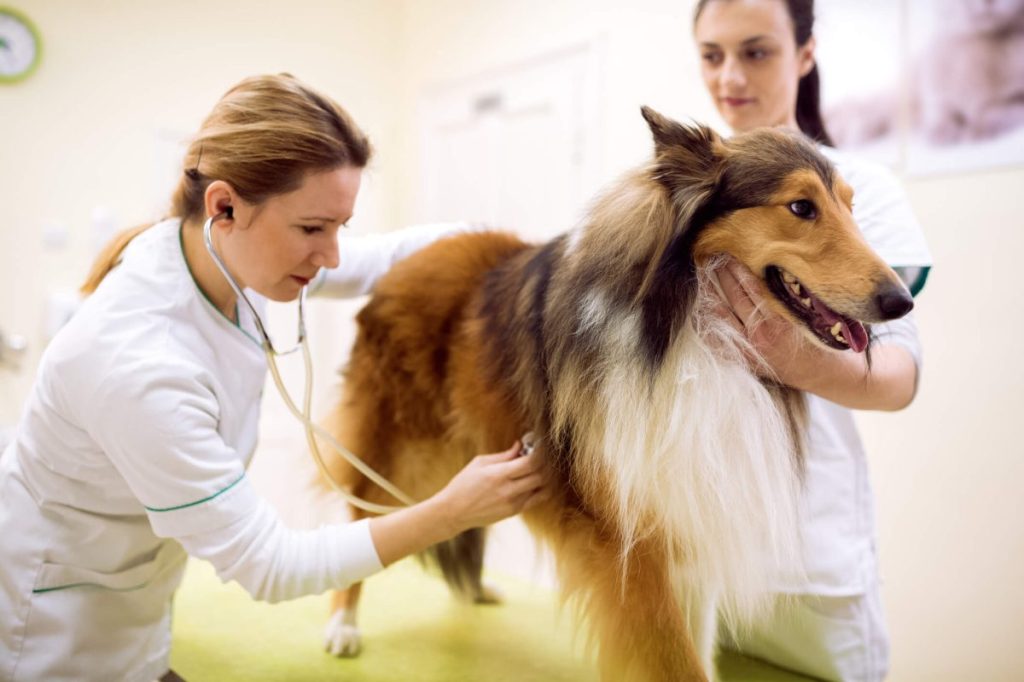Pyometra is a serious and potentially life-threatening condition that affects female dogs. The term pyometra derives from the Greek words “pyo,” meaning pus, and “metra,” meaning uterus. Essentially, it refers to an infection of the uterus that leads to the accumulation of pus. This condition can occur in any sexually mature female dog, but it is most commonly seen in older, unspayed dogs, typically those over five years of age. If left untreated, pyometra can result in severe complications, including septicemia, kidney failure, and even death.
Here’s what you should know about the symptoms, causes, and treatments of the condition.
Symptoms of pyometra in dogs

Pyometra can be categorized into two main types:
- Open pyometra: In this form, the cervix remains open, allowing the purulent discharge to escape through the vaginal canal. This discharge is often foul-smelling and may be bloody or pus-like. Symptoms are generally more noticeable.
- Closed pyometra: Here, the cervix is closed, which traps the infection inside the uterus. This type is particularly dangerous because the accumulating pus can cause the uterus to distend and possibly rupture. The lack of external discharge can also delay diagnosis and treatment, making it more life-threatening.
Accordingly, symptoms of pyometra in dogs can vary based on whether it is open or closed. Signs of open pyometra include:
- Vaginal discharge
- Frequent urination
- Increased thirst and water intake
- Lethargy
- Loss of appetite
Closed pyometra may present with the following symptoms:
- Swollen abdomen
- Vomiting
- Diarrhea
- Fever
- Extreme lethargy
In severe cases, toxins released by the bacteria can lead to septicemia and endotoxemia, which can be fatal if not promptly treated.
If you suspect your dog might have pyometra, get her to the vet as soon as possible. Your veterinarian will typically start by asking about your dog’s recent medical history and any symptoms you may have observed. A physical examination will follow, during which they will palpate your dog’s abdomen to check for an enlarged uterus.
To confirm the diagnosis, your vet will likely recommend several diagnostic tests. Blood tests are often used to look for elevated white blood cell counts, which indicate infection. Imaging techniques like X-rays or ultrasounds are particularly useful as they allow the vet to visualize the uterus and detect any abnormal fluid accumulation, which is characteristic of pyometra. In some cases, a sample of the uterine discharge may be examined to identify the bacteria causing the infection.
Causes of pyometra in dogs

Pyometra usually develops as a result of hormonal changes that occur during a female dog’s reproductive cycle. After an estrus — or heat — cycle, her body produces elevated levels of the hormone progesterone. This hormone can cause the lining of the uterus to thicken in preparation for a potential pregnancy. If pregnancy does not occur, the thickened uterine lining can create an environment conducive to bacterial growth. Escherichia coli is a common bacterium responsible for pyometra, which ascends from the vagina into the uterus. According to a study, approximately 57–100% of pyometra cases in dogs involve E. coli.
Certain factors can increase the likelihood of a dog developing pyometra. These include:
- Age: Middle-aged to older, unspayed female dogs are at higher risk.
- Breed: Breeds such as Cavalier King Charles Spaniels, Collies, Rottweilers, Golden Retrievers, and Bernese Mountain Dogs show a higher predisposition.
- Hormonal therapies: Dogs treated with progesterone-based medications for various reproductive issues have an increased risk of developing pyometra.
- Reproductive status: Females who go through multiple heat cycles without mating may be more susceptible.
Treatments for pyometra in dogs

Since pyometra is a medical emergency, timely and appropriate treatment is crucial to improve your dog’s chances of a full recovery. Fortunately, there are several treatment options available:
- Surgery: The most common and effective treatment for pyometra is the surgical removal of the uterus and ovaries, also known as ovariohysterectomy or spaying. It is typically recommended for all cases of pyometra — particularly closed pyometra — due to the high risk of the uterus rupturing and causing a life-threatening infection. Surgery not only treats the current infection but also prevents future occurrences.
- Antibiotics: Administering antibiotics can help manage bacterial infection, but it is usually a supplementary treatment to surgery.
- Fluid therapy: Intravenous (IV) fluids may be necessary to combat dehydration and support kidney function.
- Hormonal therapy: In some cases, especially in breeding dogs, prostaglandins may be used to expel the uterine contents. However, this is less commonly recommended due to potential complications and lower success rates.
Without proper treatment, pyometra can quickly become fatal. Once the infection sets in, a dog’s condition can deteriorate rapidly, often within just 48 to 72 hours. The longer the infection lingers, the more toxins that can enter your dog’s bloodstream, leading to septicemia and multi-organ failure. In severe cases, a dog may not survive more than a few days without medical intervention. However, if treated promptly, many dogs with pyometra go on to live healthy, long lives post-recovery. Always keep an eye on your dog’s symptoms and consult your vet immediately if you suspect something is wrong.
Keep in mind that the best way to prevent pyometra is to have your dog spayed before her first heat cycle. Spaying not only prevents the condition from developing but also reduces the risk of other reproductive health issues, such as mammary tumors or ovarian cancer.




